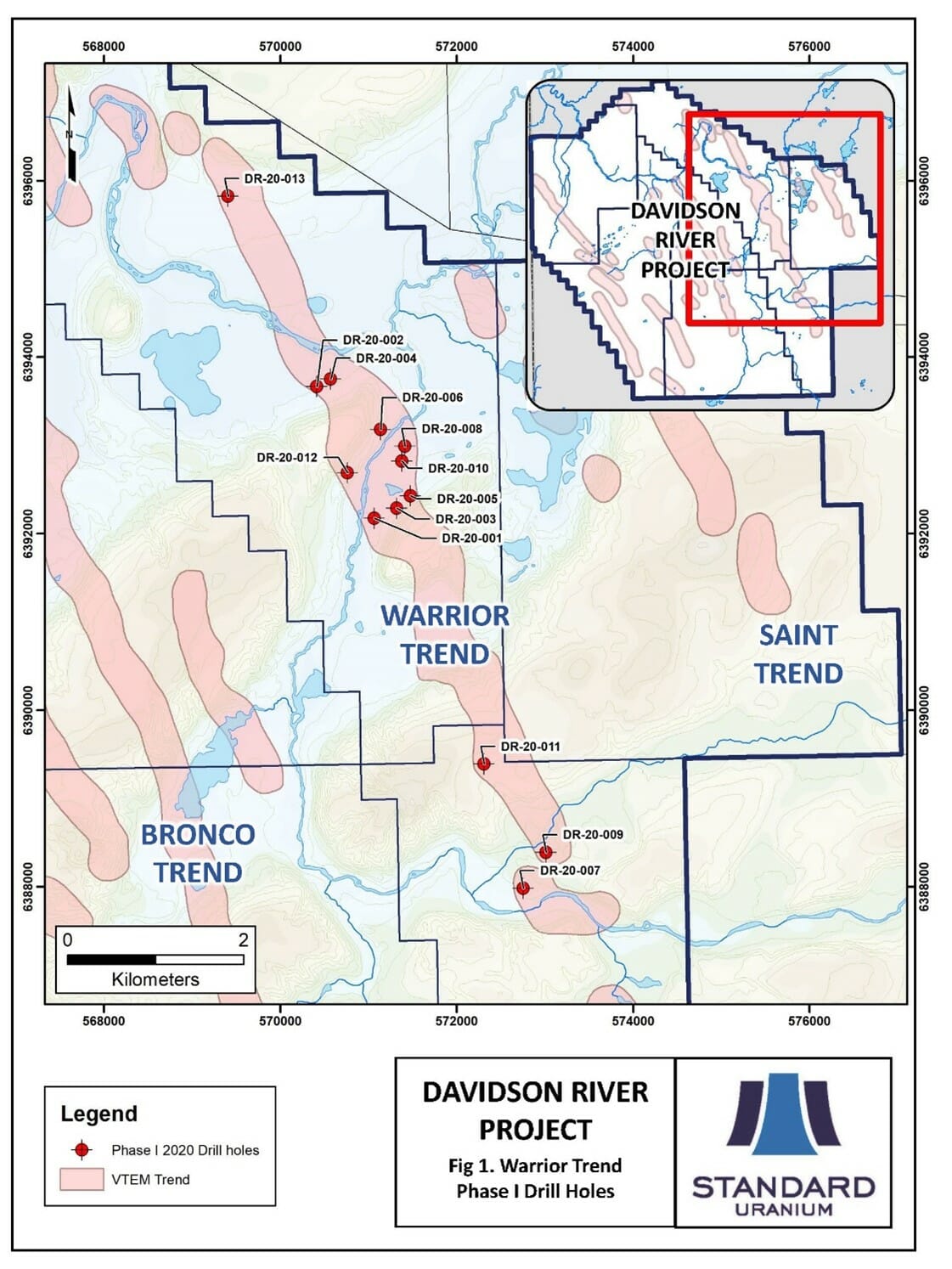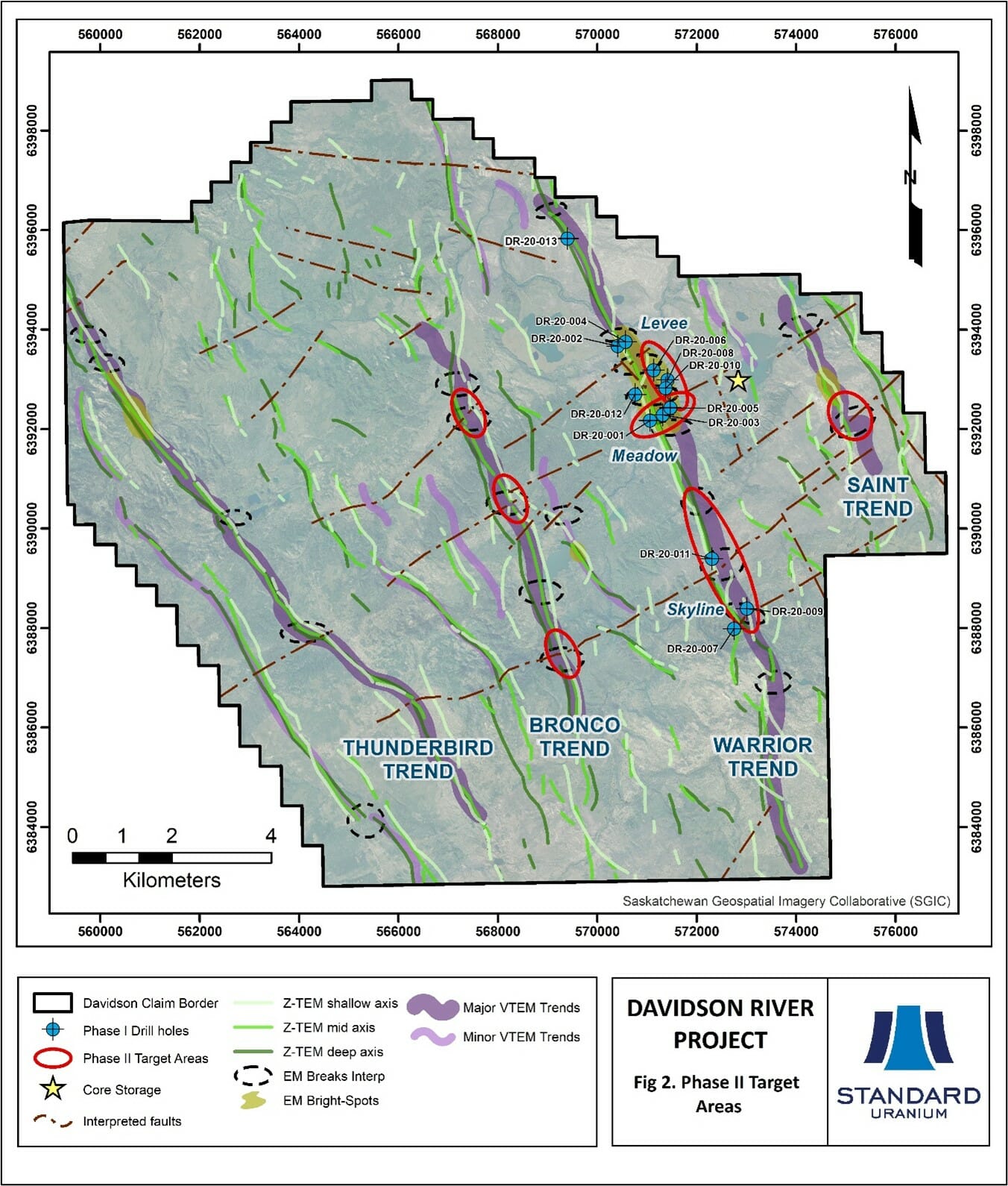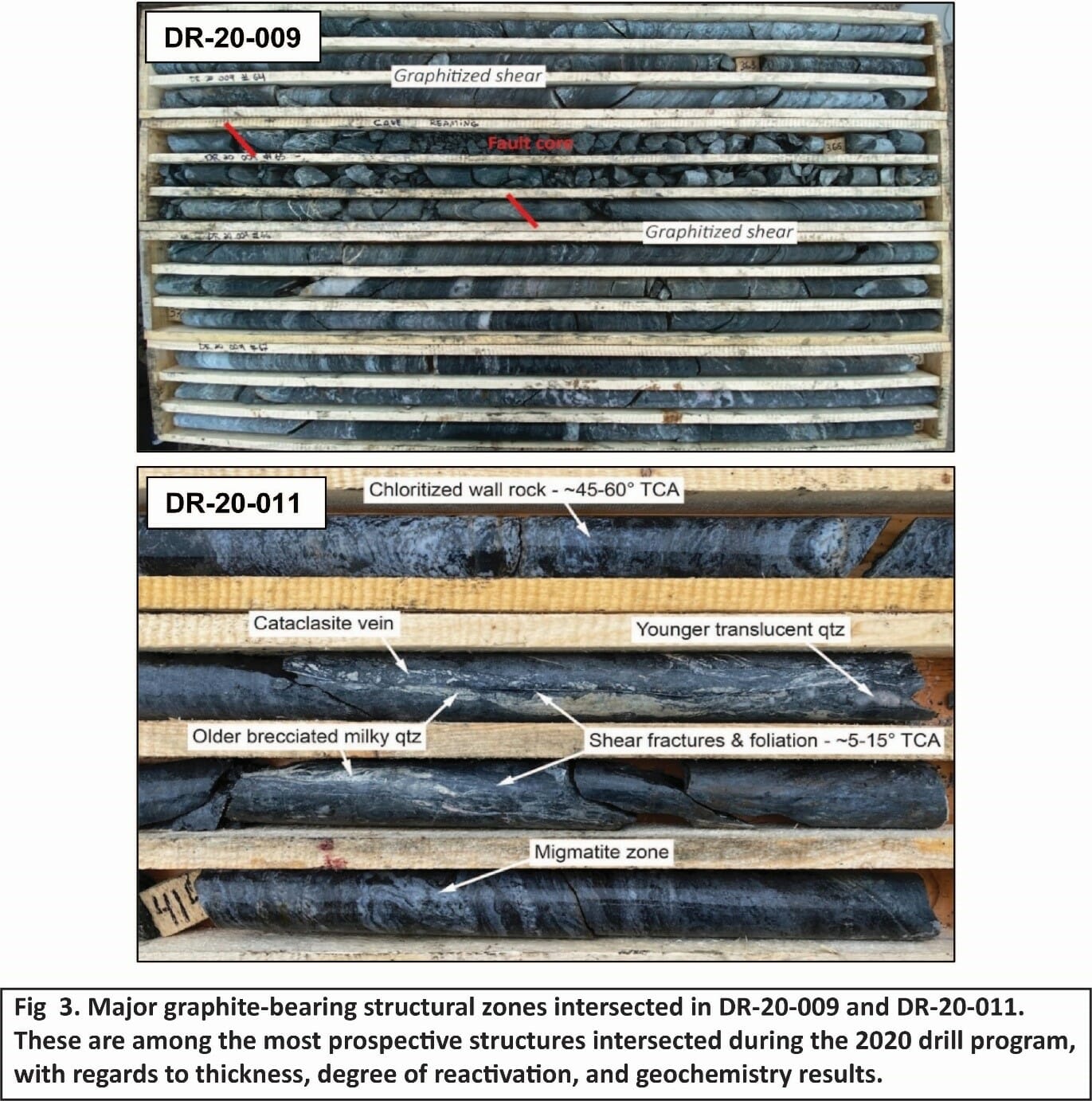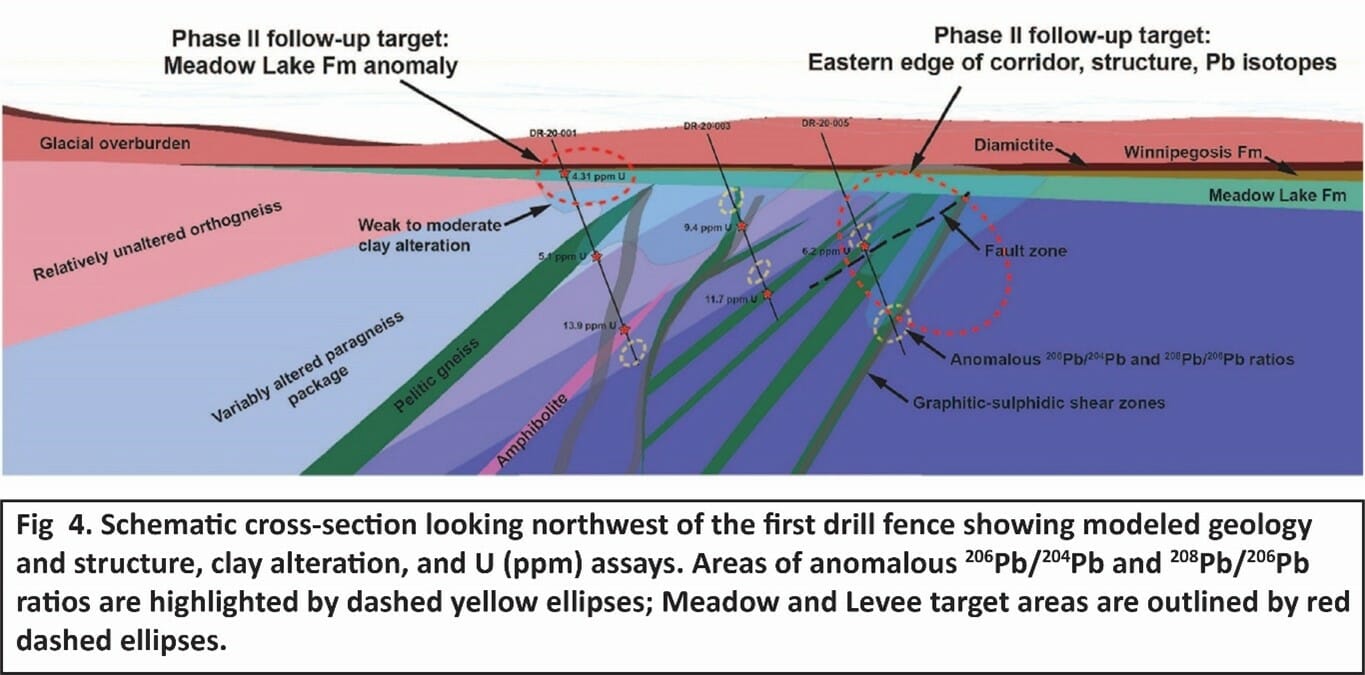Vancouver, British Columbia, November 25, 2020 — Standard Uranium Ltd. (“Standard Uranium” or the “Company”) (TSX-V: STND) (Frankfurt: FWB:9SU) is pleased to announce the company is planning a phase II diamond drilling program at its flagship 25,886 hectare Davidson River Uranium Project (the “Project”). The Project is located in the Southwest Athabasca Uranium District of the Athabasca Basin, Saskatchewan, and encapsulates the inferred trend that hosts Fission Uranium’s Triple R deposit and NexGen’s Arrow deposit, over an area 25 km to 30 km to the west of those deposits. The Phase II program is set to begin in early 2021, dependent on COVID-19. The Company is also pleased to announce a summary of results from the Phase I summer 2020 diamond drilling program at the Project.
Jon Bey, President, CEO and Chairman commented: “I am very pleased with the results of our Phase I drill program at our flagship Project that has provided our technical team with some excellent vectors to potential uranium mineralization. Based on the successful Phase I program results, we are set to begin the Phase II drill program in the first quarter of 2021. I am looking forward to what the team can achieve next year as we are fully permitted and financed to drill Phase II at our flagship Davidson River Project.”
Davidson River Phase I results summary
The Phase I drill campaign on the Project was conducted between August 4th, 2020 and September 19th, 2020. To date, 13 drill holes comprising 5,607 metres of diamond drill core have been completed along strike of the Warrior Trend (Figure 1). Over the past two years, the Company has conducted geophysical work that has identified prospective signatures for uranium mineralization associated with four main conductive corridors that comprise the Warrior, Bronco, Thunderbird, and Saint Trends. These conductive trends are believed to be associated with graphitic-sulphidic structures in basement rocks, which are commonly associated with uranium mineralization systems. This concept was proven for the Warrior trend during the summer 2020 Phase I drill program, with several instances of graphitic-sulphidic rocks and structures intersected along the tested strike length.
Highlights from the Phase I program on the Davidson River Project include:
Rock types and structure
- Drilling identified localized hydrothermal alteration and brittle to semi-brittle structural deformation zones at depths greater than 300 metres in the basement rock, consistent with those recognized in a uranium bearing system.
- Several intervals of polyphase structural disturbance were intersected in multiple drill holes, including cataclasite and breccia zones, fault cores and damage zones, and brittle-reactivated high strain zones.
- Favorable basement rock types resembling those which host other uranium deposits in the southwestern Athabasca Basin region, including stacked lenses of variably strained graphite- and sulphide-bearing garnetiferous gneisses and altered feldspar-rich rocks.
- Geological and structural modeling in three-dimensions and interpretations to date indicate that the rock packages at Davidson River are dipping moderately to the west-southwest, whereas structural zones show moderate to steep dip, with strain largely being taken up by quartz-poor and graphite/sulphide-rich units.
- The Warrior corridor is comprised of stacked lenses of quartz-poor metapelite within a variably altered paragneiss package, flanked by competent orthogneiss to the west in the hanging wall. The juxtaposition of metapelites with the relatively quartz-rich hanging and foot wall rocks creates favorable conditions for competency contrasts and focussing of strain along the Warrior conductors.
- Graphite and sulphide minerals are concentrated within discrete fault strands and high strain zones throughout the basement rocks.
- Minor lenses of amphibolite and pyroxenite were also intersected, in addition to widespread pegmatitic lenses and a localized intrusive carbonatite body in DR-20-013 to the northwest along strike (Figure 1).

Geochemistry, PIMA, and Pb isotope ratios
Systematic and feature-based whole rock geochemistry samples were taken from basement rocks in all 13 drill holes in addition to composite samples in the overlying Phanerozoic sedimentary rocks. A total of 39 sandstone and 512 basement samples were collected and analyzed, along with 282 PIMA spectroscopy samples.
Drill hole DR-20-001 returned the highest value for uranium in sandstone with 4.31 ppm U within the Devonian Meadow Lake Formation from 57.05 to 62.6 m, and is associated with other pathfinder trace elements including Mo, Pb, Cu, and As. This is almost double the next highest value of 2.60 ppm U in DR-20-005 along the same fence at 102.0 to 104.95 m, and well above the background value (~1.0 to 1.5 ppm).
Drill holes DR-20-006 and -011 returned the highest total digestion ICP-MS results for uranium in the basement with 45.1 and 29.5 ppm U, respectively. Elevated uranium values in the basement rocks are dominantly associated with metasedimentary units and pegmatites. Structural zones in the basement are locally associated with elevated uranium and/or boron values, such as in DR-20-001 (hydrocarbon fracture zone) and -011 (brittle-reactivated shear zone). These associations may indicate movement of U-bearing fluids through these structures, and possible proximity to a mineralizing system.
Basement rocks show correlation between Pb isotope ratios and elevated U, B, and other pathfinder elements, which have been integrated into the 2021 drill hole targeting. Pb ratios were calculated to identify samples that may reflect uranium mineralization through the production of uranogenic lead. Correlations have been tracked across drill fences, as well as along strike to identify broader areas of interest for follow-up Phase II drilling. The first fence drilled (DR-20-001, -003, and -005) all show elevated values between 100 to 200 m and ~350 to 400 m. Similarly, the fence containing DR-20-002 and -004 show elevated values around 250 m and holes DR-20-006 and -009 show elevated values around 250 to 300 m. Drill hole DR-20-011 to the southeast shows anomalous Pb ratios, U, B, and pathfinders above and within the major brittle-reactivated shear zone intersected from ~410 to 417 m.
Much of the Warrior trend remains untested, and there are multiple areas warranting follow-up drilling. In general, there are three main priority follow up areas to test the Warrior foot wall, and follow-up holes based on vectors including structural disturbance, anomalous uranium, boron, and pathfinder elements, and Pb isotope ratios.
Davidson River Phase II program
The majority of the work for the Phase II drill program at Davidson River will be completed using an access trail over frozen ground conditions in order to reduce exploration costs as compared to helicopter access. This work is expected to begin in early January 2021, depending on weather and local COVID-19 conditions.
The results of the Phase I drilling on the Davidson River Project have been incorporated into a comprehensive 3D model and compilation, which indicates multiple priority areas to follow-up on along the Warrior trend (Figure 2). In addition, the Company plans to begin testing other conductive corridors on the Project, including the Bronco and Saint Trends (Figure 2).

Three priority target areas along the Warrior trend have been identified for Phase II follow-up drilling:
Skyline Target Area
The deepest hole drilled on the Project (DR-20-011) intersected graphitic semi-brittle structure in the basement akin to that intersected in -009 (Figure 3). Structurally controlled graphite mineralization was intersected within the 8 m wide structure in DR-20-011, and the zone is associated with relatively elevated U (up to 8 ppm), B (up to 1,030 ppm), and other pathfinder elements. Additionally, two more zones of brittle deformation were intersected downhole from the reactivated shear at greater than 550 metres drill hole depth. Both structures display evidence for ductile shearing over several metres and notable brittle overprint by subsequent faulting (DR-20-009; Figure 3). These structures form one of the highest priority targets based on structural characteristics, as well as geochemical characteristics within and proximal to the zones. The Skyline target area which will be tested with ~200 metre step-out holes along strike targeting VTEM jogs/breaks.

Levee Target Area
Several major structures were intersected in the first drill fence (DR-20-001, -003, and -005; Figure 4) as well as in DR-20-006, -008, and -010 in the main drilling area. This coupled with the eastern edge of the corridor not being intersected to date, warrants follow up drilling in the main area to test the extent of the structures as well as an eastern Maxwell plate that remains undrilled. Additional drill holes in the Levee area will follow up on the geochemistry anomalies and to test the eastern edge of the corridor in the “main zone” on the Warrior trend. Holes along strike may also be completed to further test the eastern edge and an untested maxwell plate to the east.

Meadow Target Area
Uranium geochemical anomalies have been observed at surface and in sandstones even above deep-seated uranium deposits in the Athabasca Basin, such as Cigar Lake (450 m deep), Millennium (750 m deep) and Phoenix (400 m deep). Drill hole DR-20-001 returned the highest value for uranium in the overlying Devonian Meadow Lake Formation sandstone unit with 4.31 ppm U. Although a low value, 4.31 ppm U is more than double the background and is by far the highest value in all analyzed samples.
Drilling to the west of hole DR-20-001 will follow-up on this geochemical anomaly and test the down-dip extension of the conductive corridor, while an additional fence hole to the east of DR-20-005 will test the eastern edge of the Warrior trend (Figure 4).
Regional Targets:
Additional drill holes have been planned in high priority areas on the Bronco and Saint Trends. Regional targets are based on the same criteria as those drilled on the Warrior Trend, aiming for the combination of VTEM bright spots, ZTEM and VTEM conductor jogs/breaks, possible locations of cross-cutting structures and structural wrenching, and magnetic gradients.
Bronco Trend
Multiple high priority zones have been identified along the ~8 km long Bronco Trend, targeting VTEM and ZTEM conductor jogs and breaks associated with intersections of major interpreted faults (Figure 2). Exploration drill holes will test the center and edges of VTEM bright spots associated with the conductor breaks.
Saint Trend
The high priority target zone on the Saint Trend is comprised of a ~620 m left-lateral VTEM conductor break coincident with the edge of a VTEM bright spot and Maxwell plate off-set (Figure 2). Exploration drill holes will test the edges and center of the geophysical anomaly. This significant conductive break is the most similar on the Project in appearance to the conductive break observed at the nearby Arrow Deposit.
Neil McCallum, VP Exploration commented: “we are pleased with the Phase I results and now armed with a suite of new technical information heading into the second round of drilling. With this information in hand we have improved the discovery potential of the Warrior Trend, and other high-priority trends on the Project.”
The scientific and technical information contained in this news release has been reviewed and approved by Neil McCallum, VP Exploration and is a “Qualified Person” as defined in NI 43-101. For additional information, please reference the “Updated Technical Report on the Davidson River Property Northwest Saskatchewan, Canada” with an effective date March 16, 2020.
Drill core samples from the Phase I program were sent to SRC Geoanalytical Laboratories (SRC) in Saskatoon, SK for preparation, processing and ICP-MS multi-element analysis using Total and Partial digestion, gold by fire assay and boron by fusion. SRC is an ISO/IEC 17025/2005 and Standards Council of Canada certified analytical laboratory. Blanks, standard reference materials, and repeats were inserted into the sample stream at regular intervals in accordance with Standard Uranium’s quality assurance/quality control (QA/QC) protocols.
About Standard Uranium (TSX-V: STND)
We find the fuel to power a clean energy future
Standard Uranium is a mineral resource exploration company based in Vancouver, British Columbia. Since its establishment, Standard Uranium has focused on the identification and development of prospective exploration stage uranium projects in the Athabasca Basin in Saskatchewan, Canada. Standard Uranium’s Davidson River Project, in the southwest part of the Athabasca Basin, Saskatchewan, is comprised of 21 mineral claims over 25,886 hectares. The Davidson River Project is highly prospective for basement hosted uranium deposits yet remains untested by drilling despite its location along trend from recent high-grade uranium discoveries. A copy of the 43-101 Technical Report that summarizes the exploration on the Project is available for review under Standard Uranium’s SEDAR issuer profile (www.sedar.com).
For further information contact:
Jon Bey, President, Chief Executive Officer, and Chairman
550 Denman Street, Suite 200
Vancouver, BC V6G 3H1
Tel: 1 (604) 375-4488
E-mail: info@standarduranium.ca
Cautionary Statement Regarding Forward-Looking Statements
This news release contains “forward-looking statements” or “forward-looking information” (collectively, “forward-looking statements”) within the meaning of applicable securities legislation. All statements, other than statements of historical fact, are forward-looking statements and are based on expectations, estimates and projections as of the date of this news release. Any statements that express or involve discussions with respect to predictions, expectations, beliefs, plans, projections, objectives, assumptions or future events or performance (often, but not always, identified by words or phrases such as “expects”, “is expected”, “anticipates”, “believes”, “plans”, “projects”, “estimates”, “assumes”, “intends”, “strategy”, “goals”, “objectives”, “forecasts”, “budget”, “schedule”, “potential”, “possible” or variations thereof or stating that certain actions, events, conditions or results “may”, “could”, “would”, “should”, “might” or “will” be taken, occur or be achieved, or the negative of any of these terms and similar expressions) are not statements of historical fact and may be forward-looking statements.
Forward-looking statements include, but are not limited to, statements regarding: the timing and content of upcoming work programs; timing of geochemical results; geological interpretations; and estimates of market conditions.
Forward-looking statements are subject to a variety of known and unknown risks, uncertainties and other factors that could cause actual events or results to differ from those expressed or implied by forward-looking statements contained herein. There can be no assurance that such statements will prove to be accurate, as actual results and future events could differ materially from those anticipated in such statements. Certain important factors that could cause actual results, performance or achievements to differ materially from those in the forward-looking statements include, among others: general economic conditions in Canada and globally; industry conditions; governmental regulation of the mining industry, including environmental regulation; geological, technical and drilling problems; unanticipated operating events; competition for and/or inability to retain drilling rigs and other services; the availability of capital on acceptable terms; the need to obtain required approvals from regulatory authorities; stock market volatility; volatility in market prices for commodities; liabilities inherent in the mining industry; the development of the COVID-19 global pandemic; changes in tax laws and incentive programs relating to the mining industry. This list is not exhaustive of the factors that may affect the Company’s forward-looking statements. There may be other factors that could cause actual events or results to differ from those expressed or implied by forward-looking statements contained herein. See the section entitled “Risk Factors” in the Company’s annual information form for the fiscal year ended April 30, 2020, dated September 28, 2020 for additional risk factors that could cause actual events or results to differ from those expressed or implied by forward-looking statements contained herein.
Forward-looking statements are necessarily based upon a number of factors and assumptions that, if untrue, could cause actual events or results to differ from those expressed or implied by forward-looking statements contained herein. Forward-looking statements are based upon a number of estimates and assumptions that, while considered reasonable by the Company at this time, are inherently subject to significant business, economic and competitive uncertainties and contingencies that may cause the Company’s actual financial results, performance, or achievements to be materially different from those expressed or implied herein. Some of the material factors or assumptions used to develop forward-looking statements include, without limitation: the future price of uranium; anticipated costs and the Company’s ability to raise additional capital if and when necessary; volatility in the market price of the Company’s securities; future sales of the Company’s securities; the Company’s ability to carry on exploration and development activities; the success of exploration, development and operations activities; the timing and results of drilling programs; the discovery of mineral resources on the Company’s mineral properties; the costs of operating and exploration expenditures; the Company’s ability to identify, complete and successfully integrate acquisitions; the Company’s ability to operate in a safe, efficient and effective manner; health, safety and environmental risks; the presence of laws and regulations that may impose restrictions on mining; employee relations; relationships with and claims by local communities and indigenous populations; availability of increasing costs associated with mining inputs and labour; the speculative nature of mineral exploration and development (including the risks of obtaining necessary licenses, permits and approvals from government authorities); uncertainties related to title to mineral properties; assessments by taxation authorities; fluctuations in general macroeconomic
The forward-looking statements contained in this news release are expressly qualified by this cautionary statement. Any forward-looking statements and the assumptions made with respect thereto are made as of the date of this news release and, accordingly, are subject to change after such date. The Company disclaims any obligation to update any forward-looking statements, whether as a result of new information, future events or otherwise, except as may be required by applicable securities laws. There can be no assurance that forward-looking statements will prove to be accurate, as actual results and future events could differ materially from those anticipated in such statements. Accordingly, readers should not place undue reliance on forward-looking statements.
Neither TSX-V nor its Regulation Services Provider (as that term is defined in the policies of the TSX-V) accepts responsibility for the adequacy or accuracy of this release.
